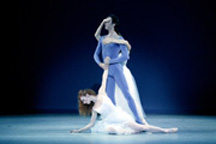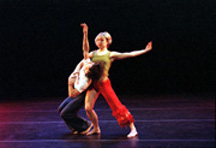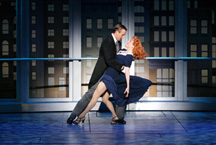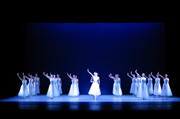Commentary
Starting Over
Suzanne Farrell Ballet
Eisenhower Theater
John F. Kennedy Center for the Performing Arts
December 2-7, 2003
by
Alexandra Tomalonis
copyright
© 2003 by Alexandra Tomalonis
 Watching
the Suzanne Farrell Ballet this past week, I kept thinking that what Farrell
is doing goes beyond starting a ballet company from scratch. She's reminding
us of why Balanchine's New York City Ballet was so treasured and so important.
I don't mean to say that she's doing this deliberately. It's more likely
she's merely trying to produce dance as though the aesthetic atmosphere
Balanchine built were still in place. For her, it clearly is. But
the rest of us have lived through two decades during which not only his
ballets, but also many of Balanchine's precepts, have become misunderstood
or distorted. "Just dance it, dear," for example, once an instruction
to resist layering artificial acting onto movement whose meaning was built
in, now seems to mean, "just do the steps; nothing else matters,"
and is applied religiously to ballets that, indeed, contain nothing but
steps. Everything is so overhyped that Balanchine's, and Farrell's, modest
way of simply doing and letting the rest of the world figure out what
they're doing—or not—can seem naive. It's hard enough to be
heard when you're whispering. It's impossible when everyone around you
is screaming.
Watching
the Suzanne Farrell Ballet this past week, I kept thinking that what Farrell
is doing goes beyond starting a ballet company from scratch. She's reminding
us of why Balanchine's New York City Ballet was so treasured and so important.
I don't mean to say that she's doing this deliberately. It's more likely
she's merely trying to produce dance as though the aesthetic atmosphere
Balanchine built were still in place. For her, it clearly is. But
the rest of us have lived through two decades during which not only his
ballets, but also many of Balanchine's precepts, have become misunderstood
or distorted. "Just dance it, dear," for example, once an instruction
to resist layering artificial acting onto movement whose meaning was built
in, now seems to mean, "just do the steps; nothing else matters,"
and is applied religiously to ballets that, indeed, contain nothing but
steps. Everything is so overhyped that Balanchine's, and Farrell's, modest
way of simply doing and letting the rest of the world figure out what
they're doing—or not—can seem naive. It's hard enough to be
heard when you're whispering. It's impossible when everyone around you
is screaming.
read review
Letter from New York
8
December 2003.
Copyright ©2003 by
Mindy Aloff
 The
Dance Theatre of Dušan Týnek—a 30 year-old native of
Czechoslovakia who studied with Aileen Pasloff at Bard, was a scholarship
student at the Cunningham Studio, and has performed for many choreographers,
including Lucinda Childs—put on several concerts this week at The
Kitchen. The program featured three works, all from 2002 and 2003. Charge,
being given its world première, is a Childs-like setting for a
soloist and a corps of six to Philip Glass’s 1987 violin concerto:
costumed like party crackers by A. Christina Giannini in shades of pale
blue, the dancers elaborate a complicated architectural analysis of the
music while dutifully acknowledging the steady pulse-patter that drives
it. One sees wonderful images—as when the soloist (Eden Mazer) runs
backward toward a line of bodies that breaks in half just as she reaches
its center. The dance means to be spellbinding, though, and is merely
hypnotic. If the only works on the program had been Charge and
the 2002 Wardrobe Spectre—a dance-theater satire to Carl
Maria von Weber’s Invitation to the Dance, for the veteran
soloist Richard Daniels and six invitees, whom he loads up with mismatched
garments that he plucks from a laundry pile in order to hammer home a
point about, as I understood it, the erotic equation between layers of
clothing and layers of fantasy—I’d have left thinking Týnek
a talent to watch and waited to see more before telling you about him.
The
Dance Theatre of Dušan Týnek—a 30 year-old native of
Czechoslovakia who studied with Aileen Pasloff at Bard, was a scholarship
student at the Cunningham Studio, and has performed for many choreographers,
including Lucinda Childs—put on several concerts this week at The
Kitchen. The program featured three works, all from 2002 and 2003. Charge,
being given its world première, is a Childs-like setting for a
soloist and a corps of six to Philip Glass’s 1987 violin concerto:
costumed like party crackers by A. Christina Giannini in shades of pale
blue, the dancers elaborate a complicated architectural analysis of the
music while dutifully acknowledging the steady pulse-patter that drives
it. One sees wonderful images—as when the soloist (Eden Mazer) runs
backward toward a line of bodies that breaks in half just as she reaches
its center. The dance means to be spellbinding, though, and is merely
hypnotic. If the only works on the program had been Charge and
the 2002 Wardrobe Spectre—a dance-theater satire to Carl
Maria von Weber’s Invitation to the Dance, for the veteran
soloist Richard Daniels and six invitees, whom he loads up with mismatched
garments that he plucks from a laundry pile in order to hammer home a
point about, as I understood it, the erotic equation between layers of
clothing and layers of fantasy—I’d have left thinking Týnek
a talent to watch and waited to see more before telling you about him.
read article
Two Musicals Where The Dancing Matters
NEVER
GONNA DANCE
Music by Jerome Kern; Lyrics by Dorothy Fields and others; Book by Jeffrey
Hatcher
Directed by Michael Greif; Choreographed by Jerry Mitchell
Broadhurst Theater
New York, NY
December 3, 2003
WONDERFUL
TOWN
Music by Leonard Bernstein; Lyrics by Betty Comden & Adolph Green;
Book by Joseph Fields and Jerome Chodorov
Directed and Choreographed by Kathleen Marshall
Al Hirschfeld Theater
New York, NY
December 4, 2003
By
Susan Reiter
copyright
© 2003 by Susan Reiter

Set in 1936, Never Gonna Dance is based on the Astaire-Rogers film Swing Time, and has two dancers as its central characters, as well as scenes set at a dancing school and an "amateur" dance competition. Its two leading performers, both veterans of Broadway dance ensembles, were cast for their dancing strengths. All of its music is by Jerome Kern: the score includes five of the six songs heard in Swing Time, plus 12 additional songs from other shows and films. This approach, of creating a "new" period musical from existing songs, is similar to that used for the two Gershwin-scored musicals My One and Only and Crazy for You.
While it
is set in 1935, Wonderful Town has a score that was written—during
a now-legendary month-long creative whirlwind—in late 1952 by three
fun-loving collaborators looking back fondly at a period when they were
in their late teens. It has a great Leonard Bernstein score that bridges
the youthful ingenuity and sass of On the Town (1944) and the
deeper and bolder innovations of West Side Story (1957).
read review
Deconstructing the Balanchine Couple
The Suzanne Farrell Ballet
Eisenhower Theater
The John F. Kennedy Center for the Performing Arts
Washington, D.C.
December 5, 2003
by
Clare Croft
copyright © 2003 by Clare Croft
The fledgling
Suzanne Farrell Ballet has spent the last seven weeks touring the U.S.,
but it saved its Balanchine Couple program for Washington audiences. On
Friday night, the troupe performed a series of nine pas de deux, all introduced
by Farrell herself. Although the crafting of the program was somewhat
unusual, there were several moments of quality dancing as well as insight
into Balanchine’s proces. There
wasn't an obvious thematic link among the selections, and it might have
helped if Farrell had explicitly stated that the duets were presented
in (nearly) chronological order. Without this explanation, one might wonder
why
Meditation ,with its contemporary dress and hint of story, followed
the stripped down, black and white Agon, for example? Each may
be a gem in its own right, but what do they have to do with each other?
How do the nine chosen duets (also Chaconne and excerpts from
Apollo, La Sonnambula, La Valse, Don Quixote and Stars and
Stripes) fit within the Balanchine repertory? Normally, these are
questions left for post-performance discussion, program notes, critics
or historians, but the inclusion of Farrell’s mini-lessons shifts
the responsibility to provide context and cohesion onto the performance
itself..
read review
reprinted from last week's Midweek Extra
Dancing to Tchaikovsky
All
Tchaikovsky Evening
Suzanne Farrell Ballet
Eisenhower Theater
John F. Kennedy Center for the Performing Arts
[December 2-7, 2003]
December 2, 2003
by
Alexandra Tomalonis
copyright
© 2003 by Alexandra Tomalonis
 “For
dancing, always Tchaikovsky,” Balanchine is said to have said once,
and Tchaikovsky’s music certainly figures prominently in his work.
From Serenade, the first ballet he choreographed in America,
to Mozartiana, which received its premiere at the New York City
Ballet’s Tchaikovsky Festival in 1981, Tchaikovsky’s music
inspired some of Balanchine’s most beautiful ballets.
“For
dancing, always Tchaikovsky,” Balanchine is said to have said once,
and Tchaikovsky’s music certainly figures prominently in his work.
From Serenade, the first ballet he choreographed in America,
to Mozartiana, which received its premiere at the New York City
Ballet’s Tchaikovsky Festival in 1981, Tchaikovsky’s music
inspired some of Balanchine’s most beautiful ballets.
Both these
works, as well as the Tschaikovsky Pas de Deux and “Tempo
di Valse,” a/k/a The Waltz of the Flowers from The Nutcracker,
made up the Suzanne Farrell Ballet's opening night program. The company
is part of the Kennedy Center’s own Tchaikovsky Festival that will
include the Kirov Ballet and Opera at the end of the month. Washington
has been privileged to watch Farrell’s small company grow. This
year is the first time we’ve seen it at the end, rather than the
beginning, of its season (it's just come home from a tour) and, in Serenade
especially, Farrell’s group of in-between-jobs and off-season dancers
really looked like a company and not a workshop group.
read review
Tudor, Forsythe and New Works at the New Skirball
ABT
Studio Company
Skirball Center
New York, NY
December 5, 2003
By
Susan Reiter
Copyright
© 2003 by Susan Reiter
In recent seasons, attending a performance by American Ballet Theatre's 12-member "second" troupe has provided (among many other pleasures) an early glimpse of the next generation of brilliant, memorable ABT male dancers. Within the past few years, one could discover the very young Herman Cornejo, Craig Salstein and Danny Tidwell—all of whom moved swiftly, and authoritatively, into the ABT ranks.
The Studio
Company's most recent New York season—its first at the attractive,
recently opened Skirball Center on the NYU campus—showcased an engaging
ensemble rather than drawing attention to any individual dancer in quite
the same way. Ten of the twelve are new since the troupe last performed
in New York in April; several of them came through ABT's thriving Summer
Intensive program, and several of them had made a notable impression at
its culminating performance in July.
read
review
|
|
|
|